Heading out the door? Read this article on the new Outside+ app available now on iOS devices for members! Download the app.
When Hannah Dewey skis, she likes to go fast. “I tend to powerhouse it,” she says. “I muscle my way through.” As a longtime skier and a professional wildfire fighter, Hannah is strong enough to ski fast, even uphill. But after 22 years of skiing, she’s learned something surprising, a lesson that comes from her yoga practice: To get the most power, she has to slow down and focus her mind on the present moment. “If I go calmly step by step, concentrating on my form, I can actually go faster,” she says.
I met Hannah, along with more than 40 other skiers, at the eighth annual Women’s Ski and Yoga Retreat in the Methow Valley of northern Washington. I joined a group of athletes who do yoga for many reasons: to enhance their performance on skis, to ward off injury, and to experience the singular bliss that comes from a focused effort and a clear mind. “Yoga and skiing go together for me,” says Mary Ellen Stone, another retreat regular. “They’re both ways of putting away all the clutter in our lives and focusing physically, emotionally, and technically on something that’s not easy to do. But when it all comes together, it’s one of the best feelings in the world.”
I’d come to have my own experience of the synergy of yoga and skiing, but because I hadn’t skied since I was a kid, getting faster was not my primary goal. Still, the lessons I’d internalized in my years of yoga practice turned out to serve me well on the trails.
Let It Snow: The Pre-Ski Yoga Warm-Up
The secluded Methow Valley is a Nordic skier’s paradise. A popular place for Olympic skiers to train, the valley has 120 miles of cross-country trails—one of the longest systems of groomed trails anywhere in North America—as well as access to many more miles of challenging backcountry ski routes in the 4 million acres of the surrounding Okanogan-Wenatchee National Forest.
The women meet at Sun Mountain Lodge, the mountaintop resort hosting the retreat, which is organized by the nearby Winthrop Fitness center. Many of my fellow retreat participants have skied competitively. Some are experts at downhill skiing but have come to master cross-country. A few are snow-sport newbies like me.
At 7 o’clock the next morning, I warm up my resistant quadriceps in Melanie Whittaker’s yoga class. Melanie is a cross-country skier and the yoga director for Winthrop Fitness, and has been practicing yoga for more than 30 years. She teaches an Iyengar-inspired style and counts elite skiers and other athletes among her students. She explains that we’re preparing ourselves to move forward with agility and speed while balancing on a slippery and constantly changing surface of snow and ice. For the next 90 minutes, she leads us through a series of strong poses like Ardha Chandrasana (Half Moon Pose) and Virabhadrasana (Warrior Pose) I, II, and III, which call for strength, balance, and confidence—the same qualities we’ll need to draw on once we strap on our skis.
Moving with any sort of grace on a slippery surface is inherently challenging, she tells us, as we do Utkatasana (Chair Pose), and to keep our balance we’ll need a strong, compact form and a low center of gravity. She also reminds us that to be successful at skiing, as with yoga, we have to learn to trust our bodies. When we do Handstand, she reminds us that it is trust that allows us to bring our hips over our heads, and our legs into the air. I’ll have occasion to remember her words later in the day.
See also6 Best Yoga Poses for Snow Sports
Free Fall: A Yogi Learning to Ski
After class I make my way, skis in hand, to a flat, groomed field for my beginner’s lesson. A misty fog floats across the hills, just above the treetops, and occasional watery sunshine glints from behind the clouds.
The two most common kinds of cross country skis—classic and skate—have corresponding, but different, techniques. To move forward on classic skis, you keep your feet parallel and execute a series of gliding lunges. With each step, you shift your center of gravity forward, bringing your body weight fully over the ball of the front foot, almost past the point where you feel you’re going to fall, while pushing the ground away with your back leg. To balance and stay stable, says my instructor, you tuck into an Utkatasana-like form, bending your front knee and ankle, dropping your sitting bones, and firming your core.
When I ask some of the more experienced skiers, like Hannah, how their yoga practice supports their skiing, they emphasize core strength and balance. “In skiing, my form comes from my core,” says Hannah. “I concentrate on keeping my core really tight, and my legs just follow.” As the ski class gets under way, I see what she means. If I bend my ankles and knees and tip my weight forward, I glide. If I straighten up out of that slight tuck, I wobble and, more often than not, fall.
“Bend your knees and ankles,” shouts my instructor. “Weight forward!” I bend my knees. I bend my ankles. I drop my sitting bones, finding the skier’s Utkatasana. I connect to the strength in my ankles, calves, and thighs and, with a slight adjustment, release my body weight forward. And there it is. I am gliding with a remarkable feeling of ease, making wide turns down the slope. I no longer feel that the skis are unruly clown shoes, tripping me up. They are seamless extensions of my legs, and they do my bidding.
That afternoon, we take off down a trail into the forest. I experience a delicious sense of well-being and freedom as I slide through the quiet forest and enjoy the afternoon sunlight gleaming through pine trees decked with garlands of sage-green moss. I’ll never look at Utkatasana the same way after today. Instead of feeling like a sweaty struggle for balance, it now feels like the pose of victory.
See alsoLace Up + Let Go: Yoga Poses for Figure Skaters
Apres-Ski Restorative Yoga
That evening, the group meets for an apres-ski stretch, and I find Melanie for a quick consultation. All of that forward crouching has left me with a sore back. She has me try a variation of Sphinx Pose, in which I press my hands into the ground and work my upper arms toward each other to open up my upper back and chest. A supine twist relieves my lower back, and Supta Baddha Konasana (Reclining Bound Angle Pose) helps release the piriformis, a muscle deep in the buttocks that tends to tighten in skiing.
As to my other aches and pains—I’m feeling my shoulders, arms, core, inner thighs, outer thighs, calves, and ankles—she tells me I’m making the rookie mistake of unnecessarily gripping a lot of auxiliary muscles I don’t need to in the process of trying to engage the ones I do. “You’ll get more power and control when you learn to isolate the muscle groups you need,” she says. “You’ll also be a lot less sore and fatigued at the end of the day. Practicing the body awareness you learn in yoga will help you on the slopes.”
See also7 Restorative Poses to Stay Grounded This Winter
Finding Balance on Skis
In the next morning’s yoga class, Melanie brings our attention to our feet. Being aware of our feet, she tells us, is a critical factor in balance. In Utthita Parsvakonasana (Extended Side Angle Pose), we practice putting even pressure through the entire foot, observing how the slightest shift to one side can unbalance us.
The skiing portion of the second day focuses on skate-style skiing. Skate skis are especially slippery. When you are moving across the snow’s slick surface, the slightest muscular effort creates motion, which presents a new kind of balancing challenge. To gain control of my movement, says my instructor, I have to master the art of “edging,” or delicately shifting weight to the inner edge of my foot to grip into the snow, which will allow me to push off into a glide.
As I slide around like a bumper car, I try to remember to spread my toes and keep my feet relaxed so that I can control how my weight shifts. Meanwhile, I’m fielding more instructions: Bend your knees, push off the back foot, shift weight to the front foot, bring one pole forward. Every time I try to do one thing the instructor tells us, I forget the others, tense up, and lose my balance. Finally she notices my difficulty and gives me yet another instruction: “You—just stop thinking!”
I pry my gaze away from my feet, look straight ahead in the direction I want to go, and thrust myself forward into a glide. I plunge forward, and this time I start to get the momentum, the slight swaying, the powerful back-leg strokes pushing me forward. I grin like a little kid, glancing at the teacher to make sure she sees me before my next slippery fall.
And then it occurs to me: Balance is not something you achieve and hold on to. It’s more ephemeral; it’s a string of temporary successes, held momentarily, lost, and then discovered again. Skiing gives you a fleeting experience of balance with each shift of weight and each glide. But it’s not permanent. When you lose it, you just have to have faith that you’ll come back to it.
Sweet Surrender: The Synergies of Yoga and Skiing
I feel I’ve been treated to a glimpse of the synergies of yoga and skiing. Hannah told me that her favorite yoga teacher reminds her to slow down and stay focused when she starts to rush through her Sun Salutations. Of all the benefits that her practice confers on her sport, she says, the most important one has come in the form of a mental shift: “Yoga has helped me slow down and concentrate on myself, and on having a good time out there.”
Mary Ellen echoes this sentiment: “When you’re out there and you see the snow sparkling on the trees and hear the ravens calling, you think, ‘I’m so lucky, so extraordinarily lucky, to be doing this.’ It’s a deep feeling, being there, right in that moment. That feeling is hard to come by.”
After dinner on the last night of the retreat, I make for the hot tub. I set my chin on the cold rock ledge of the tub and count a handful of lights in the houses in the valley below. The rest of my view consists of the snow-blanketed Mount Gardner. The full moon shines through the spreading branches of a pine tree on the slope before me. A rumbling sound disturbs the quiet as the trail grooming machine starts up. To my ears, it’s a sweet sound, promising freshly groomed trails to glide down in the morning.
Balance- and Strength-Building Yoga Sequence for Snow Sports
Snow sports like cross-country skiing, snowboarding, and downhill skiing allow you to descend, traverse (and even fly!) through rugged glaciated mountains and trail systems. You’re navigating a slippery surface that offers little resistance to slow you down, so you need a heightened sense of balance along with focused strength in your core, back, and legs.
This sequence focuses on honing your balance and strengthening the key muscle groups that you use in snow sports—the quadriceps, glutes, ankles, abdominals, and back. If you’re a regular skier, doing these poses throughout the season will enhance your experience on the slopes. If you’re new to snow sports, practicing this sequence regularly for several weeks before you intend to strap on your skis, board, or skates will help you build the strength you’ll need. And if you’re going skiing today, moving through this sequence first will wake up the key muscle groups you’ll be calling on.
Utkatasana (Chair Pose), variation
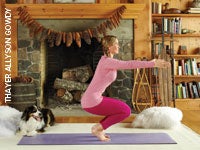
In downhill turns, the weight is distributed slightly forward over the arches of the feet at the start of the turn and slowly shifts to the back of the arch as you finish the turn. This variation of Utkatasana imitates that movement. The slightly crouched posture, powerful core, and strong legs of Utkatasana are what allow you to make these subtle weight shifts.
From Tadasana (Mountain Pose), with your feet hip-width apart, raise your arms in front of you to the height of your shoulders, parallel to the floor, palms facing inward. Bend your knees and lower your torso as if to sit in a chair. Draw your navel back in the direction of the spine as you lower the sacrum and tailbone down toward the floor, tucking the tailbone under slightly. Reach forward through your fingertips and, at the same time, draw your shoulder blades toward each other and down your back. Continue to lower until your thighs are as nearly parallel to the floor as you can get them. Lift your torso as you press into your heels. Rise up on the balls of your feet, lifting your heels 2 or 3 inches off the floor, or higher if you can. Hold for 30 seconds and then drop your heels, straighten your legs, and come out of the pose. Repeat 5 times and come back to Tadasana.
Adho Mukha Svasana (Downward-Facing Dog Pose)

Downward Dog strengthens the ankles, core muscles (both abdominal and back), upper back, shoulders, and arms, and stretches the calves, hamstrings, and buttocks—all of which work to stabilize you on the snow.
Come onto all fours, with your shoulders over your wrists, your hips over your knees, and the knees 4 to 6 inches behind the hips. Curl your toes under and, as you exhale, lift your sitting bones toward the ceiling. Keep your knees slightly bent and heels off the floor at first. Press the tops of your thighs back and, as you stretch the backs of your legs, press your heels down. Press firmly into the palms of your hands and all of your fingers, keeping your upper back wide and your shoulder blades drawing down your back toward your pelvis. As you inhale, press into the palms of your hands and the balls of your feet. As you exhale, keep your core active as it supports you in the pose. Feel the extension through the spine and side waist as your arms and legs are actively engaged in the stretch. Feel calmness as you breathe evenly in the pose. Remain in the pose for 30 to 60 seconds.
Virabhadrasana (Warrior Pose I)
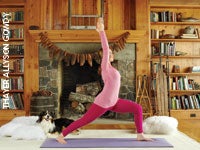
When you ski, your balance constantly shifts as you move across the snow or ice. In strength-building Warrior I, you practice the concentration required to maintain a balance between forward movement in the upper body and grounding down in the back leg, ankle, and foot.
From Downward Dog, step your left foot forward and place it between your hands. Turn your right foot in 45 degrees and lower the heel. Keeping a deep bend in your left knee, bring your torso upright, raising your arms overhead. Press down firmly with the back foot while squaring the front of your pelvis as much as possible with the front edge of your mat. Inhale and reach through your arms, keeping your shoulder blades drawing down and back and your low belly moving in and up. Observe yourself maintaining the balance between the forward movement of your torso and the grounding action of your back heel and leg. Feel the opening of the chest and the stretch in the abdominals and left hip flexors. Hold for 30 to 60 seconds, return to Downward Dog, and repeat on the other side. Return to Tadasana.
This variation of Warrior III strengthens the feet and ankles, back, abdominals, adductors, and quadriceps. It stretches the glutes, hamstrings, and abductors. It also teaches balance. Entering this pose from Tadasana accentuates the muscle action used in Nordic skiing.
Virabhadrasana III (Warrior Pose III), variation
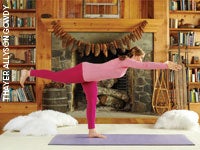
From Mountain Pose (Tadasana), step forward about 2 1/2 feet with the left foot. Press into the left foot, bending the knee slightly. Engage your quadriceps and slowly lean your torso forward, flexing at the hips. Slowly lift the right leg out behind you while reaching your arms forward, shoulder-distance apart and palms facing inward. Keep your weight centered over the arch of the left foot. Straighten out the right leg and press back evenly through the heel and ball of the foot. Straighten the left leg and balance with your back leg, arms, torso, and hips parallel to the floor. Engage your gluteus muscles and keep your hips level as you maintain length through the torso. Stay here for a few breaths. To further strengthen the core, legs, and ankles and to improve balance, try alternating between a straight and bent supporting leg. Exhale as you bend the knee, keeping your torso parallel to the floor. Inhale as you straighten the leg. Continue for 6 repetitions and then repeat on the other side. Come into Downward Dog for a few breaths and then come onto all fours.
Alternate Arm and Leg Lifts
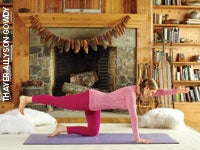
This pose imitates the alternating arm and leg movements of cross-country skiing. It helps develop the strength and stability in the torso that you will need to maintain your balance while opposite limbs are in motion. It also strengthens the upper back, shoulders, abdomen, spinal extensors, and hamstrings.
From your hands and knees, with your shoulders directly over your wrists and your hips over your knees, inhale and lift your left arm to shoulder level, reaching out through your fingertips, and lift your right leg parallel to the floor, reaching back through your toes. As you reach through your limbs, lengthen your spine, extending forward with the crown of the head and back through the tailbone. Keep your pelvis in neutral and your belly firm. Stay in the pose for 30 seconds, come back to all fours, and then repeat on the other side. Do the pose a total of 5 times, and then sit on the floor with your legs extended in front of you in Dandasana (Staff Pose).
Paripurna Navasana (Full Boat Pose)
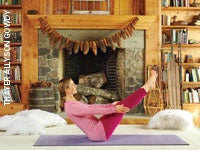
Core strength in both the front and back body is essential for maintaining stability on skis. Navasana strengthens the abdomen, psoas, hip flexors, and spinal extensors while challenging you to balance evenly on three “points”—the two sitting bones and the tailbone.
Rock back slightly to balance on your sitting bones and tailbone without rounding your back. Bend your knees, and lift your feet off the floor. Once you feel balanced, straighten your legs to a 45-degree angle from the floor. (If this isn’t possible, remain with your knees bent, perhaps lifting the shins parallel to the floor.) Lift your arms so they are parallel to the floor, palms facing each other. (Alternatively, hold on to your legs behind the knees.) Lift from your sternum, engaging your core and maintaining length in your side waist. Reach out through your fingertips, but keep the shoulder blades integrated into the back. Breathe smoothly while you soften your gaze. Hold the pose for 30 to 60 seconds and then return to Dandasana. Repeat 3 times.
Jathara Parivartanasana (Revolved Abdomen Pose)
Finish with this twist, which is also good for apres-ski, because it relieves soreness in the lower back and can help relieve upper-back stiffness.
Lie on your back with your arms out at your sides, palms facing down, knees bent, and feet flat on the floor. Inhale and draw your knees toward your chest. Exhale and lower your knees to the right side, with your thighs at a 90-degree angle to your torso. Allow your hips, thighs, and buttocks to relax. Without straining your neck, turn your gaze to the left. Gently press your left shoulder blade into the mat and lengthen the left side waist by drawing your left hip down toward your heels. Breathe evenly through the twist. To take the twist deeper, bring your right hand to your left thigh behind your knee and gently stretch to the right. Stay in the pose for 6 to 9 breaths. Inhale, bring your knees to center, and place your feet on the floor with knees bent. Lift your hips a few inches and adjust their placement so your spine is straight. Repeat the twist to the left side, and then take Savasana (Corpse Pose).
See also4 Poses for Snowboarders